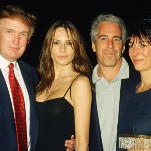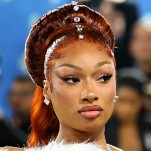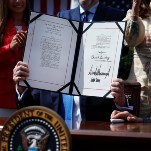The documentary Hugh Hefner: Playboy, Activist and Rebel claims to go beneath Hef’s bathrobed persona to reveal the man who championed civil rights, equality, and free speech. Critics say it’s a two-hour infomercial that glosses over Playboy‘s objectification of women.
The film, which opens today, shows that over the years Hef has aligned himself with various laudable causes, including civil rights, the anti-war movement, and equal rights for women. However, it doesn’t examine the negative effects Playboy has had on American culture, or why Hef felt a nudie magazine was the best way to promote these causes.One possible explanation is that German director Brigitte Berman’s goal was to show “the other side of Hugh Hefner that had not yet been portrayed in any of the prior documentaries about him.” But since it ignores the darker side of Playboy, the film comes off as a Hefner hagiography.
Below, the reviews:
-

-

-

-

-

-

-

-

-

-

-

-

-

-

-

-

-

-

-

-

-

-

-

-

-

-

-

-

-

-

-

-

-

-

-

-

-

-

-

-








































